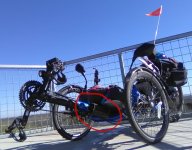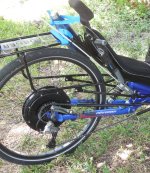ccihon
100 W
I have previously converted my older tadpole trike to hub drive - using 52v battery, generic 9C clone 1000w motor and KT sine-wave controller. Works well, and I able to do about 30mph throttle alone. What I don't like is dealing with the larger controller, the weight of the big hub motor, and the lack of gear choices etc. I have the battery mounted down low and to the side, which works well, and have the controller and other electronics in the rigid tail box: see build here: https://endless-sphere.com/forums/viewtopic.php?f=6&t=112009
My plan: replace the hub motor and controller with a BBSHD mid drive up front, and use the original 9 speed rear wheel/cassette and hub at the back. This would allow me to loose the tailbox, and continue using my battery arrangement.
Pros/Cons/Considerations
-Cost- the motor and needed pieces will be 700-1000US, but maybe can resale the hub motor and supporting pieces?
-Speed - I think geared correctly, it appears I will have similar top-speeds, and likely better climbing
-Weight reduction, at least a bit
-Efficiency for power usage - no real idea here?
-Reliability - the current setup has been reliable, the mid could be harder on the chain and driveline, I know
-Regen braking - will lose this, but now only use it set at a very low level as I have no good way, at least yet, to incorporate a good torque arm for the hub motor on this frame
-Noise? not sure how big a deal this is
Would love expert opinions on this plan.
My plan: replace the hub motor and controller with a BBSHD mid drive up front, and use the original 9 speed rear wheel/cassette and hub at the back. This would allow me to loose the tailbox, and continue using my battery arrangement.
Pros/Cons/Considerations
-Cost- the motor and needed pieces will be 700-1000US, but maybe can resale the hub motor and supporting pieces?
-Speed - I think geared correctly, it appears I will have similar top-speeds, and likely better climbing
-Weight reduction, at least a bit
-Efficiency for power usage - no real idea here?
-Reliability - the current setup has been reliable, the mid could be harder on the chain and driveline, I know
-Regen braking - will lose this, but now only use it set at a very low level as I have no good way, at least yet, to incorporate a good torque arm for the hub motor on this frame
-Noise? not sure how big a deal this is
Would love expert opinions on this plan.



